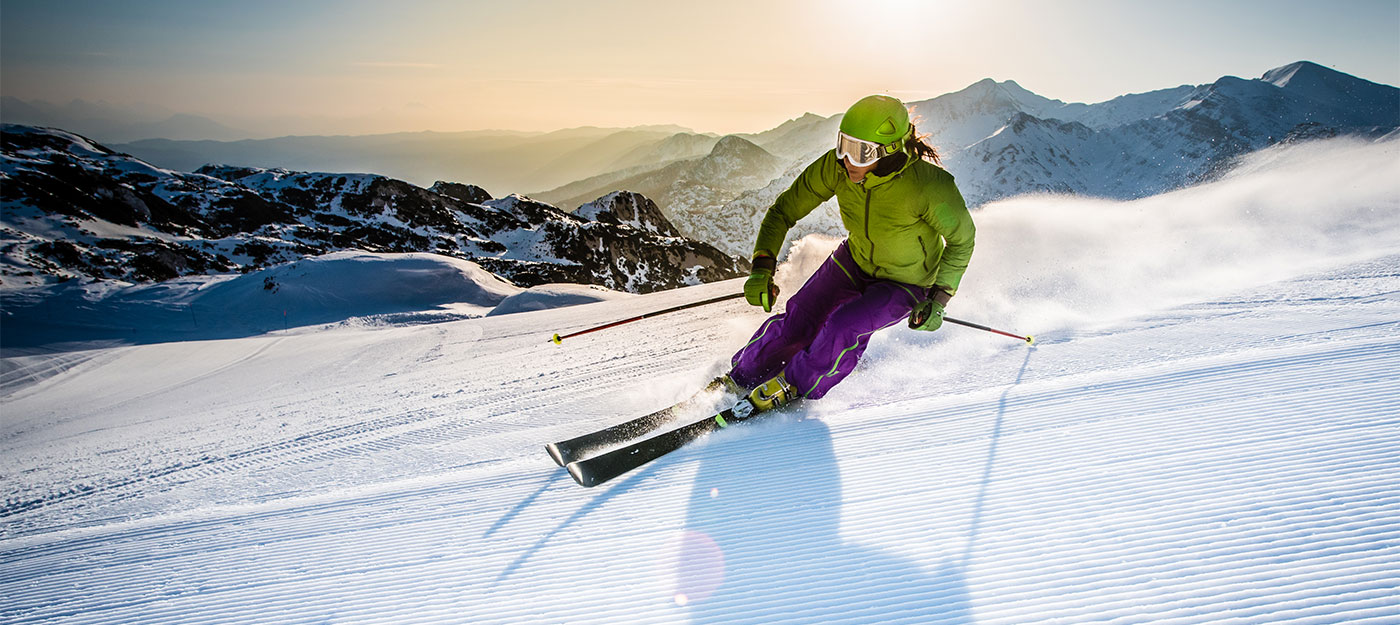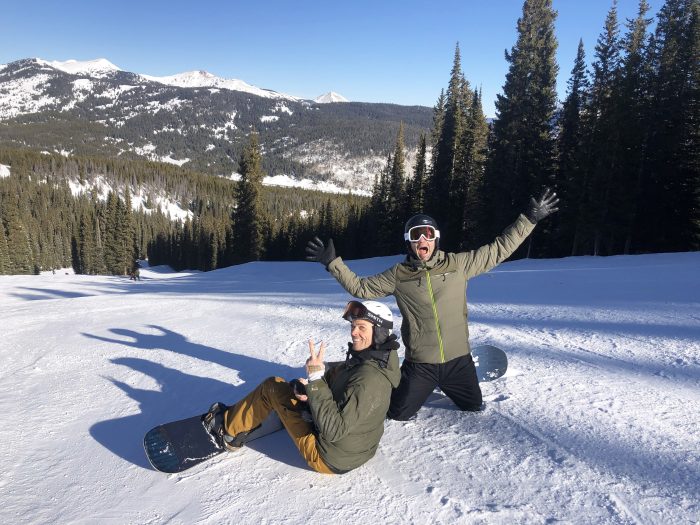
Animal Flow for Snowsports
It’s a cold, crisp, bluebird day. Fresh powder fell overnight, and every tree and trail is blanketed by a white, silky snow cover. The light wind picks up tiny particles that glisten in the air. I buckle up my boots, clip on my skis, take a deep breath and start carving lines through the soft, untouched powder. It feels like I’m floating, carried by the snow, making turns, almost in slow motion. My arms are wide open, my core is engaged and my legs are strong, yet I feel weightless.
If you’ve ever skied, snowboarded, surfed or skated, you have probably experienced this very feeling at some point. When everything feels effortless and movement happens without thinking, just like surfing a wave, you’ve reached the ‘flow state.’ It’s this same mental state that regular Animal Flow practitioners, or Flowists, experience frequently and, on the snow, it’s the exact feeling that keeps us hooked on our sport. However, it doesn’t come without a bit of effort and the right preparation.
Physical preparation for the slopes
As a trainer, when I started helping clients prepare for their ski trips, I used different training techniques and tools such as TRX, Fitball and BOSU. After being introduced to Animal Flow back in 2014, I realized that it offered a new way to combine body and space awareness (known as proprioception), endurance, core activation, stability and balance. I saw a surprising yet very natural correlation between quadrupedal movement training and snowsports that would ultimately help my clients perform better on the slopes.
The performance requirements for snow sports are a mix of linear and non-linear movements with variable times under tension. In an NSCA Journal article, ‘Skiing: Physiological training for competitive alpine skiing,’ author Steven Plisk describes competitive skiers as having “exceptional strength in the foot extensors, thigh and trunk. They tend to place themselves in a flexed position (with knees and hips flexed between 45 and 90 degrees)… Alpine skiing requires strength under both static and dynamic conditions.”
Simply put, this means that to be great on the snow, you’ll need to be strong through your legs and core while maintaining a substantially flexed position. Furthermore, you’ll need to be able to stay strong under changing conditions.
While typical gym-based ski programs that incorporate linear movements such as squats and lunges can certainly improve strength, staying injury-free and performing optimally on the snow requires you to have a range of fitness abilities. Stability, agility and mobility are critical for resilience and performance, two of the four pillars that underpin the Animal Flow methodology. For this reason, traditional linear training is unlikely to be sufficient as a solitary means of preparation.
Let’s look at the challenges that you’re likely to face whenever you set foot (or ski or board) on the snow, and how a regular Animal Flow practice can help to overcome them.

Animal Flow Creator Mike Fitch (left) and Master Instructor Sascha Müller (right) are avid snowboarders.
Physical challenges in snowsports
Challenge #1: Awareness
Whether you’re an avid ski bum or not, you can likely agree that it’s not easy to ride a pair of skis or a snowboard downhill while avoiding other people, dips, bumps or icy patches. It requires extreme awareness of yourself and your surroundings, excellent reactivity and maximum proprioception.
It all starts from your feet. To become an even better rider, you’ll want to focus on increasing your awareness of the movements of your feet inside your boots. The slightest foot or toe movement impacts your skis or board.
In Animal Flow, moves like the Underswitch, Side Kickthrough or Front Step can help you bring attention to your foot placement and balance. By focusing on your feet in these movements, you should feel more grounded which is valuable on the snow. For example, as you perform the Side Kickthrough, keep your eyes on the base foot, watching it pivot to 90 degrees from where it starts. Looking at the foot allows you to control every degree of rotation and, when the heel drops, this rotation continues through your leg into your hip. This is an excellent way to see and feel the connection between your foot and the rest of your body.
Challenge #2: Fast decision-making
As you get better on the snow, faster decision-making is necessary to avoid crashing. Your body and brain must be in tune to feel and react. When we call out a Flow, Flowists must listen to the instructions and translate them into movement. The faster and more complex the Call Out, the faster you need to move in response.
It’s the same on the snow. The faster you can feel your environment, the faster you can make the necessary alignment corrections in order to stay stable. But for this to happen, you must train your brain.
In this way, Animal Flow can provide a ripe training methodology for body and brain integration. A 2016 study by Matthews et al., showed that Animal Flow could improve cognitive flexibility in as little as four weeks, so even if your ski season has already kicked off, you’ve still got time to reap the benefits for your brain.
Challenge #3: Speed and stability
One of the first rules in Animal Flow is that you should only go as fast as you can control. If you can’t control the movement, it not only looks and feels sloppy, but you’re also reducing the intended benefits of it. Additionally, your brain and body are not learning how to create stability in order to transfer power. Skiing is the same. You can’t afford to lose control so the faster you go, the more aware and stable you must be.
More dynamic Animal Flow moves like Jumping Side Kickthrough, Underswitch Tap and Front Kickthrough provide the challenge of controlling speed, decelerating momentum and creating whole-body stability from the ground up.
Challenge #4: Endurance and resilience
Slow movements enhance what’s known as ‘time under tension’––the length of time that muscle tissue contracts against a strain of some kind, be that the weight of your body under gravity or that of an external load such as a barbell.
In snowsports, our muscles can be under load for lengthy durations so training by applying longer periods of time under tension can help to build resilience and endurance.
A slow Beast Reach, Underswitch or Full Scorpion challenges us to control the force we put into the floor in order to create a stable base while the rest of the body contracts to control the speed of our movement.
The Static Beast Activation on its own is a great stationary drill to build trunk and thigh endurance. From this position, set Loaded Beast and perform a Front Step or Front Kickthrough, and you’ll add core control and dynamic loading of the legs and feet. The three-dimensional movements found in Animal Flow train your joints through different ranges of motion for better stability and improved soft tissue elasticity, both of which are important factors for resilience.
Applying Animal Flow to your snowsports preparation program
With all of the above in mind, if you want to reduce your risk of injury and train for longevity on the snow, it’s beneficial to train in a way that allows you to target the following:
- Stability
- Both static and dynamic loading
- Reactivity/change of direction and tempo
- Foot control and awareness
- Asymmetric loading of body parts.
When I train my ski clients, I integrate all of the above into their program, which includes adding Animal Flow moves. The combinations are almost endless which makes it fun and challenging! Here are some examples of combining more traditional training methods with Animal Flow.
Agility and AF
I personally like to use an agility ladder and hurdles for footwork, speed and direction changes (brain) and combine Animal Flow rotational movements. Try these two examples.
Dumbbells/Kettlebells and AF
Kettlebells or dumbbells are a good way to load one side of the body while moving. This helps train anti-rotation movement, which helps fight that G-force when skiing. You can easily combine some Animal Flow moves with weights to add the extra stability challenge.
Balance trainers and AF
BOSU trainers, wobble boards, sliders and boxes can help train stability and balance. Going from an unstable standing position to the ground challenges you to keep your core muscles engaged in an effort to fight against gravity as it acts on your body.
There are so many different ways to train for snowsports. As long as you focus on moving in three dimensions, use different loading positions, connect with your feet (barefoot or with minimalist shoes) and use tempo changes, you will be fit to ski in no time.
QMT for snowsports session
Using the exercises from above, here’s a workout plan to help you get ski fit. You can find tutorials for each of the AF movements at Animal Flow On Demand and, as always, if you’re not sure if this session is suitable for you, consult your health professional or find a Certified Animal Flow Instructor.
- Perform a warm-up comprised of 3-5 mins of Wrist Mobilizations and 5 mins of Form Specific Stretches (such as this ‘Simple Morning Flow’).
- Then move to conditioning. Perform 3-5 rounds of each combination below. Rest 2 mins before moving to the next one. For each combo, either aim for 60-90 secs of each drill or 12-15 repetitions.
1A) Static Beast with dumbbell drag
1B) Crossover lunge/Side Kickthrough
2A) BOSU side shuffle/Front Kickthrough
2B) BOSU squat jumps/ Front Step
3A) Ladder side shuffle/ Lateral Traveling Ape Version 1
3B) Hurdle high jumps/Jumping Underswitch
- Cool down for 10 mins. Try incorporating 3-4 repetitions of Wave Unload and Scorpion Reach, then focus on stretching your calves, quadriceps, hamstrings and glutes.
Quadrupedal Movement Training, like Animal Flow, adds resilience and connection to your linear training. It’s an easy addition since the only equipment you need is your body and a little space, and it challenges you to be mindful of how you move and use your body. All of these elements are essential to help you ‘feel’ the snow better, recover faster after long sessions on your skis, and make the most of those bluebird days!
Looking for some more guidance on getting started? Try this follow-along 30-minute beginner Animal Flow class. In this follow-along workout, Animal Flow creator Mike Fitch takes you through some Wrist Mobilizations before teaching you several introductory movements. Learn the movements as individual drills and then build them together into your first Flow.
